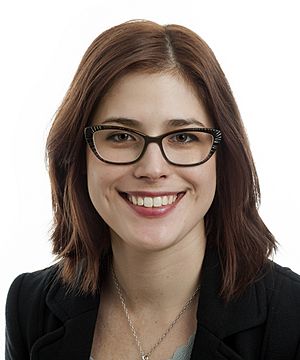Carsen Stringer facts for kids
Quick facts for kids
Carsen Stringer
|
|
|---|---|

Stringer in 2017
|
|
| Nationality | American |
| Alma mater | University of Pittsburgh University College London |
| Known for | Suite2p calcium imaging analysis software |
| Awards | Culver Award for High Achievement in Mathematics, Peter F.M. Koehler Academic Achievement Award in Physics |
| Scientific career | |
| Fields | Computational Neuroscience |
| Institutions | Janelia Research Campus |
Carsen Stringer is an American scientist who studies the brain. She is a Group Leader at the Howard Hughes Medical Institute Janelia Research Campus. Stringer uses machine learning and special computer programs called deep neural networks. She uses these tools to look at how the brain works when it sees things. She also creates new computer programs to help other scientists study the brain.
Contents
Early life and education
In 2009, Carsen Stringer started college at the University of Pittsburgh. She studied Applied Mathematics and Physics. She worked on designing artificial body parts (prostheses) and learned how math helps understand how living things stay balanced.
In 2013, Stringer moved to the United Kingdom. She went to University College London for her advanced studies. There, she combined her math skills with her knowledge of the brain. She studied how many brain cells (neurons) work together. She wanted to understand how the brain processes what we see. She also looked at how the brain's internal state affects what it sees. Her research used recordings from the visual part of a mouse's brain.
Stringer also helped create a computer program called Suite2p. This program made it much easier to process videos of brain activity. It helped scientists analyze brain recordings from special imaging techniques.
Career and research
After finishing her PhD in 2018, Stringer began working at the Howard Hughes Medical Institute Janelia Research Campus. She learned new ways to use deep learning. These tools helped her analyze images and understand brain signals. She also learned how to find important information from large brain recordings.
Today, Stringer leads her own team called the Stringer Lab at Janelia. Her team creates computer tools for brain scientists. Stringer also teaches other scientists how to use these tools.
The Stringer Lab also tries to understand how the brain codes information. They use computer models that are inspired by how the brain works. They compare these models to real brain activity data. This helps them learn how the visual part of the brain understands what it sees. They have found that the brain's responses to sights are very complex. They are always finding new ways to understand this complex data. A main goal of the Stringer Lab is to understand how the brain uses what it sees and how it behaves to make decisions.
Understanding how the brain sees
During her studies, Stringer looked at how large groups of brain cells work together. She wanted to understand how the brain's own activity affects what it sees. She created a computer model to study this. She found that a type of brain cell, called inhibitory neurons, seemed to play a big role. These cells help control the brain's activity. Her work showed how important these cells are in how the brain processes information.
Making brain imaging better
Calcium imaging is a powerful way to see brain activity. Stringer has worked hard to make this tool even better. She has helped scientists understand the best ways to analyze calcium imaging data. She found that a method called non-negative deconvolution (NND) was best for figuring out when brain cells are active. This method was also faster and more accurate.
Stringer looked at all the steps in analyzing calcium imaging data. She found ways to fix problems that could lead to wrong results. Her work is very important. It helps scientists get more accurate information from their brain imaging studies.
Awards and honors
- 2009–2013 University of Pittsburgh Chancellor's Scholarship
- 2012 Peter F.M. Koehler Academic Achievement Award in Physics
- 2012 Culver Award for High Achievement in Mathematics
- 2013 NSF-GRFP

